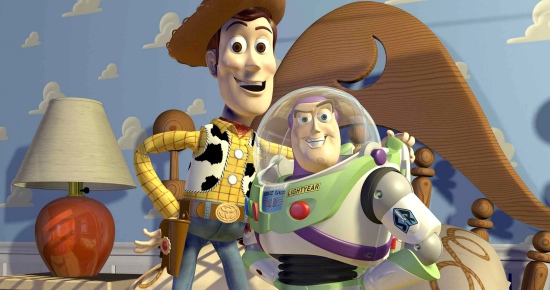
Agree or disagree about how Star Wars and Jaws shifted our habits of moviegoing forever but I don’t think I’ll be able to swallow any argument that tells me John Lasseter’s sublime Toy Story wasn’t a turning point in modern film history. There are far more fully-CG toons being catapulted into the market place now, week in, week out, than we ever received from the cel-animation studios. At the moment, far more family films are being rendered in vast farms of computers than are photographed on sound stages. Would this still have been the case had Toy Story not been so darn brilliant?
I’d say almost definitely not. Getting into the CG toon game can’t have been cheap, and without a sure-fire smash like Toy Story to dangle the mother of all ‘Nevermind’ dollar bills before the nascent industry, maybe even Dreamworks, the first of the imitators, wouldn’t have taken the dive, let alone to other, trailing copyists.
So, Toy Story’s legacy is vast. And, more specifically, it is one of those rare films with a sequel that outstrips the original’s achievements. Could it possibly stand up today?
You betcha. Even before this big screen rerelease, I already knew for sure that Toy Story was standing up just fine. I’ve got a well-loved DVD copy (or two) that have been in fairly regular rotation, both at home and in the classroom where I teach. I was not at all surprised by how timeless the film was.
Nor was I surprised that this new 3D incarnation worked wonderfully too. I’m a loud, proud advocate for the new 3D cinema, particularly via the Real-D polarized specs system. And the attention to detail we’ve come to expect from Pixar has been extended deep into this process of dimensionalisation too.
Unlike Coraline, for example, where major gear changes in the 3D cinematography are used to clearly delineate sections of the film, there’s a lot more subtle shifting in Toy Story. Having said that, we rarely see the space ‘fully expanded’ or ‘fully contracted’ except when there’s a clear turning point in the narrative to mark it – witness Woody sitting, alienated, on the desk in Andy’s room. The translation to 3D is sensitive, witty and absolutely non-intrusive throughout.
The box office seems to be telling a true success story, but 3D cinema has been failing to find traction with a large portion of the audience and some serious cineastes. Could Toy Story, the toon that made the chin-stroking critics sit up and take notice of mainstream animation for the first time in decades, do the same for stereoscopic movies?
I hope so. It certainly undermines most of the typical criticisms about how 3D filmmaking is pointless and gimmick laden. When a shot in the 3D version of Toy Story seems designed to poke out sharply into the audience, or another suddenly opens up a vast deep vista before us, we shouldn’t forget that this must have also been the case in 2D. Yep, that’s right – two dimensional films also try to give us these big 3D experiences, only without the literal third dimension. They try to imply it, and in most cases, they use versions of the same tricks.
The upcoming third Toy Story film has been tooled from the ground up for stereo cinema and it seems good artistic sense as well as a commercial move to reconfigure the first two chapters to fit.
The capabilities of the Pixar animators, technicians and software have leapt forward hugely since this first feature film, but while each Toy Story film has showcased advances over the last, they have done so without shaming the predecessor. Two answers key answers as to why this would be are pretty simple to grasp. One: the design in the first film avoids the giveaways and tells that could have ruined the sense of reality. For the most part, we’re in a sufficiently well rendered universe of simple, easy to manage textures – the plastic factor, if you will; and two: the animation has always been compelling and convincing, with its sense of reality created through identifiable characterization and fully believable sense of mass and motion.
Despite being a film that’s over 13 years old and cheaply available on DVD here, there and everywhere, as well as already having a place a phenomenal amount of collections, Toy Story seems once again to be the best option for theatergoers this weekend. Come and see it with a crowd again, on the biggest screen you can and with the added bonus of 3D presentation.
Many people were asking James Cameron and Avatar to shoulder the responsibility for proving the artistic value of 3D. Job done, pressure off – Pixar have already put up the case-closing evidence for him. The artistic techniques afforded by the ‘second eye’ that are on show here are every bit as powerful, and I believe ultimately as essential, as those granted by the use of colour, of surround sound, of being able to change the lens on the camera or to use steadicam.
0 komentar:
Post a Comment